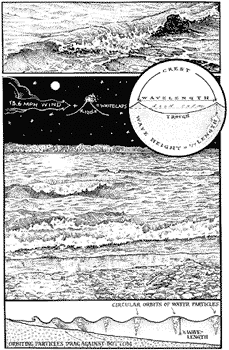







This issue's book excerpt comes from The Bird in the Waterfall: A Natural History of Oceans, Rivers, and Lakes by Jerry Dennis with drawings by Glenn Wolff. Jerry and Glenn are the creators of the critically acclaimed It's Raining Frog's and Fishes and in this book continue probing the boundaries of the natural world with their own blend of fact and fiction, word and image. The Bird in the Waterfall will be released in hardcover by HarperCollins Publishers on July 27th.
This excerpt from the chapter entitled Waves and is presented in a browsable format for your enjoyment. Following the links as they are laid out will make the most sense, but the reader, of course, is free to chart his or her own course.
 I can hear waves tonight from my living room. Our house is a few hundred yards from Lake Michigan, on the east shore of a peninsula where east winds strong enough to build large breaking waves are unusual. But tonight the wind is strong and the waves are big. They come in cadence, the largest of them building to a peak and pausing,
their power suspended for a moment in a silent heaving purl before
they crash. They break with a hydraulic thump sudden as an ax blow,
making the ground shudder, and are followed instantly by a tumbling,
swirling rush of released energy that hisses like urgent low voices in a crowd. Intermediate waves run in long lapping strokes the length of
the shore, like tongues licking envelopes, their breaking less sudden,
announced with preambles. The sounds make me remember nights
I have spent in sleeping bags on other beaches. Waking on a warm
summer night to the rhythm of waves is as reassuring, you can imagine,
as the sounds of breathing and heartbeat to a fetus in the womb.
Maybe we remember it somehow. Maybe hearing waves in darkness
awakens us to our beginnings.
I can hear waves tonight from my living room. Our house is a few hundred yards from Lake Michigan, on the east shore of a peninsula where east winds strong enough to build large breaking waves are unusual. But tonight the wind is strong and the waves are big. They come in cadence, the largest of them building to a peak and pausing,
their power suspended for a moment in a silent heaving purl before
they crash. They break with a hydraulic thump sudden as an ax blow,
making the ground shudder, and are followed instantly by a tumbling,
swirling rush of released energy that hisses like urgent low voices in a crowd. Intermediate waves run in long lapping strokes the length of
the shore, like tongues licking envelopes, their breaking less sudden,
announced with preambles. The sounds make me remember nights
I have spent in sleeping bags on other beaches. Waking on a warm
summer night to the rhythm of waves is as reassuring, you can imagine,
as the sounds of breathing and heartbeat to a fetus in the womb.
Maybe we remember it somehow. Maybe hearing waves in darkness
awakens us to our beginnings.
The waves that break against the shores of oceans and lakes were here long before our beginnings. They have been here as long as there has been liquid water and wind to loan it energy. They are energy, traveling through water the way sound travels through air. They are energy made audible and visible and set in motion, a rippling of water's muscles.

How waves begin is no mystery...
As a breeze touches a calm lake, areas of ripples appear, often in uneven, roundish shapes mariners have for centuries called "cat's- paws."
Swell waves travel beyond the wind, either leaving the area where it is blowing or continuing on after the wind has ceased.
The steepness of a wave never exceeds a 1:7 ratio of height to length.
Outtakes I, II, III & IV:
When waves enter shallow water they undergo dramatic changes.
Like waves of light, water waves can be diffracted, reflected, and refracted when they encounter stationary objects or shoreline features.
The writer Henry Beston, who spent a year living on the shore of Cape Cod before writing his nature classic, The Outermost House, proposed that the best time to be on a beach was when the surf was high. It was then, he wrote, that the breaking waves seemed to charge shore like warhorses: "As they approach, the wind meets them in a shock of war, the chargers rear but go on, and the wind blows back their manes. North and south, I watch them coursing in, the manes of white, sun-brilliant spray streaming behind them for thirty and even forty feet. Sea horses do men call such waves on every coast of the world."
Tonight on my own small coast of the world the waves charging to the shore are steady and insistent and fill the night with the noise of culminating forces. I listen to the thump of breaking waves and realize that each wave borrows its sound from the wind, which has plenty to spare, then alters it to match its shape. It is a sound with crests and troughs in it, with rhythms as elemental as the beating of our hearts and as ancient as the phases of the moon. Wind has always paired with water to make such sound. Waves have always ended this way.
Excerpted from The Bird in the Waterfall:
A Natural History of Oceans, Rivers, and Lakes,
by Jerry Dennis, with illustrations by Glenn Wolff.
Available July 27, 1996 from HarperCollins Publishers.
Copyright 1996.


